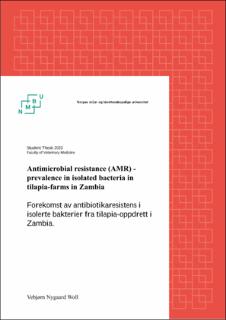| dc.contributor.advisor | Evensen, Øystein | |
| dc.contributor.author | Woll, Vebjørn Nygaard | |
| dc.date.accessioned | 2023-06-08T11:06:02Z | |
| dc.date.available | 2023-06-08T11:06:02Z | |
| dc.date.issued | 2023 | |
| dc.identifier.uri | https://hdl.handle.net/11250/3070535 | |
| dc.description.abstract | Antimicrobial resistance is an emerging threat to human and animal health. It is driven by increased use and poor practices. The use of antimicrobials in aquaculture has been shown to increase the prevalence of antimicrobial resistance. This study examined the prevalence of antimicrobial resistance against commonly used antimicrobials in tilapia farms in Zambia. Samples were collected at eight different farms in the Copperbelt region, and around Siavonga and lake Kariba. Bacterial isolates were tested for antimicrobial resistance through disk diffusion on Mueller-Hinton agar. The bacteria were sequenced through 16S-sequencing for identification. A questionnaire given to the fish farms reported a low usage of antimicrobials in the farms visited. The antimicrobial resistance observed was generally low among most antimicrobials tested. | en_US |
| dc.publisher | Norwegian University of Life Sciences, Ås | en_US |
| dc.rights | Attribution-NonCommercial-NoDerivatives 4.0 Internasjonal | * |
| dc.rights.uri | http://creativecommons.org/licenses/by-nc-nd/4.0/deed.no | * |
| dc.title | Antimicrobial Resistance (AMR) -Prevalence in Isolated Bacteria in Tilapia-farms in Zambia | en_US |
| dc.title.alternative | Forekomst av antibiotikaresistens i isolerte bakterier fra tilapia-oppdrett i Zambia. | en_US |
| dc.type | Student paper, others | en_US |

